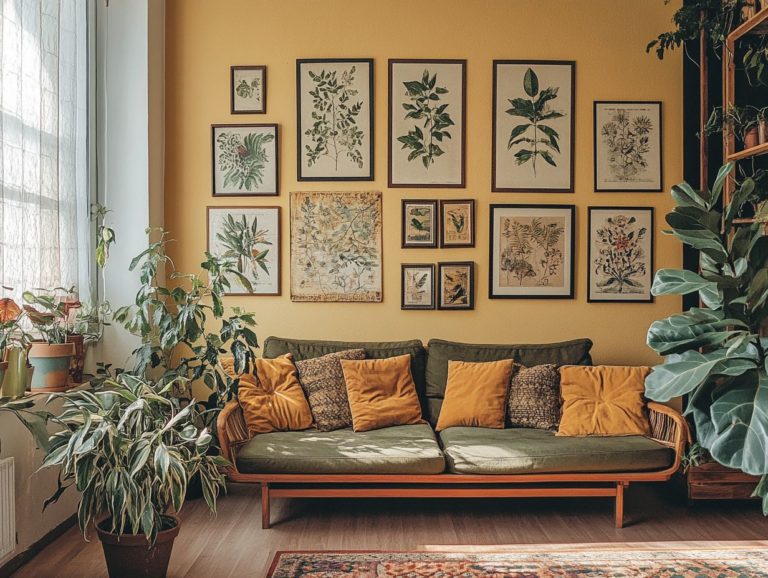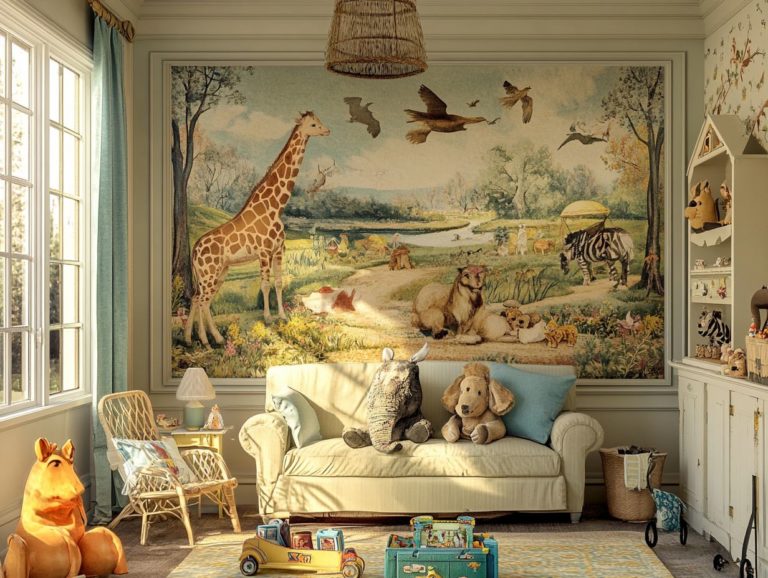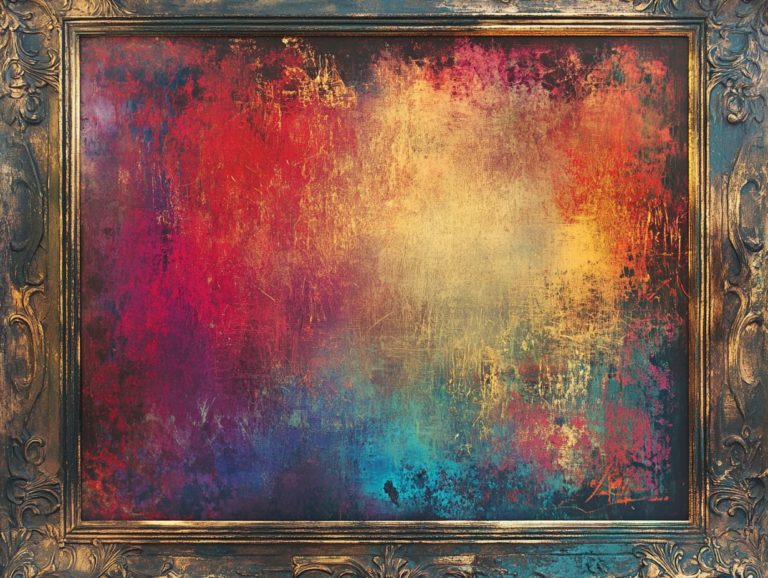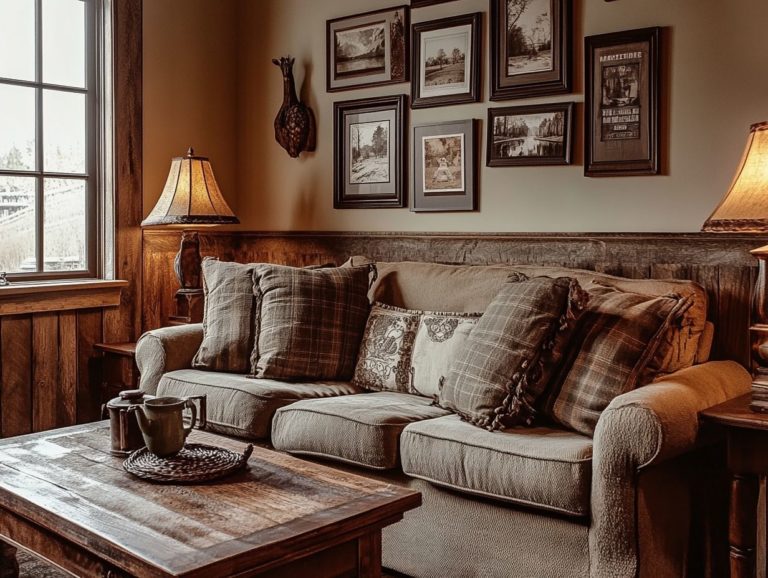How to Care for Vintage Wall Art
Vintage wall art transcends mere decoration; it serves as a captivating window into history, capturing the stories and styles of eras long past.
These cherished pieces often hold both sentimental and monetary value. It s crucial to understand how to care for these treasures to preserve their beauty and integrity.
This guide delves into the significance of vintage wall art, offering effective cleaning techniques and best practices for display and storage. Each section empowers you with the knowledge to maintain and enjoy your collection for years to come.
Contents
Key Takeaways:
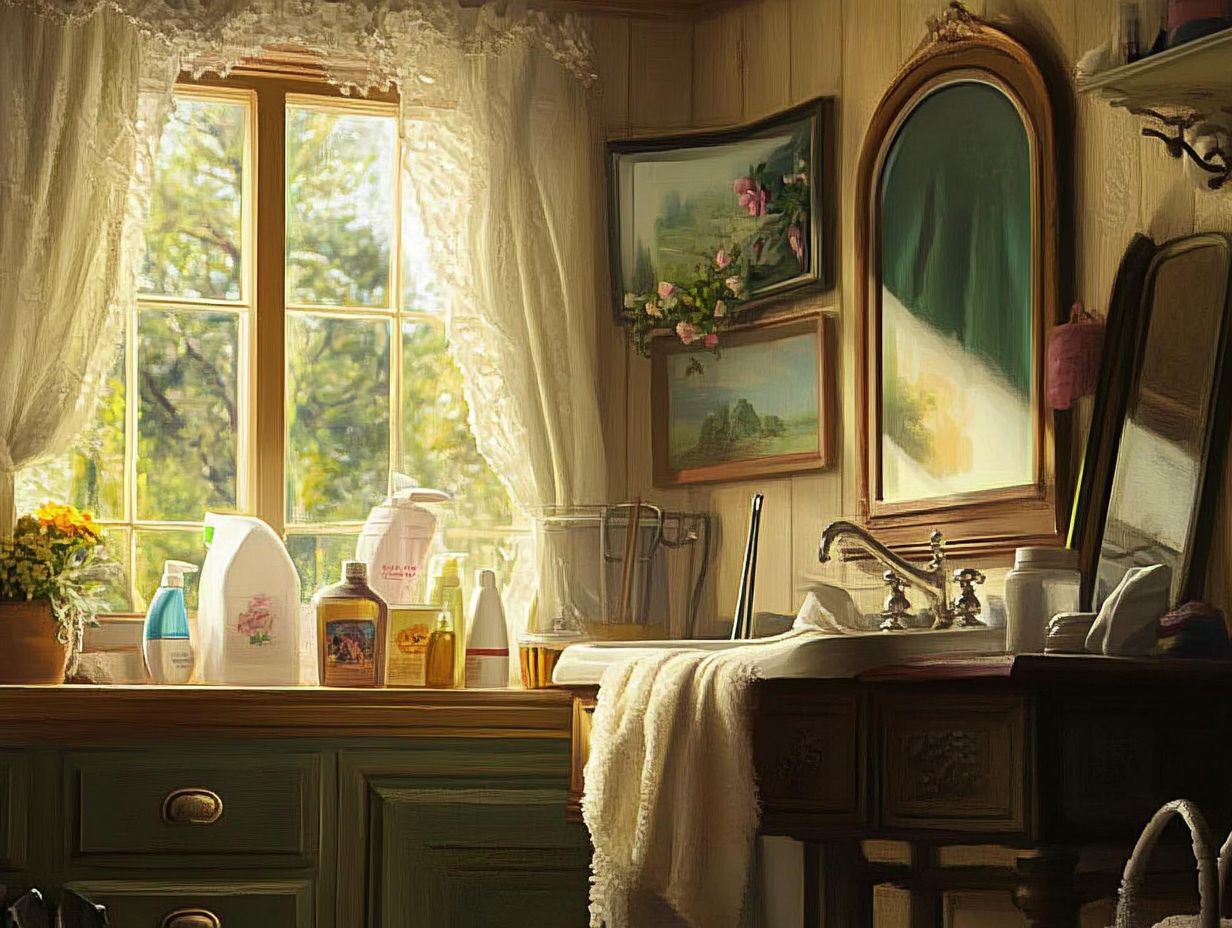
- Protecting your vintage wall art means safeguarding memories for future generations.
- Proper cleaning techniques and regular maintenance prevent damage and prolong the lifespan of your art.
- Identify and address common issues while following best practices for display and storage to ensure longevity.
What is Vintage Wall Art?
Vintage wall art is a remarkable collection of masterpieces. It often showcases iconic works from celebrated artists such as Claude Monet, Pablo Picasso, and Mark Rothko. Each piece embodies distinct historical, cultural, and aesthetic values from various art movements.
These vintage paintings, alongside Japanese woodblock prints, do more than simply adorn your walls; they serve as windows into the past, reflecting your family heritage and artistic innovation.
As you explore the diverse styles of vintage wall art, you may find yourself enveloped in a sense of nostalgia. You’ll encounter everything from the bold colors of Abstract Expressionism to the delicate lines of Art Nouveau. Each style narrates its own story, echoing the emotions and experiences of its era.
Collectors pursue these artworks not just for their visual allure but for the emotional resonance they capture reminders of fleeting moments and shared memories. The historical significance intertwined with these pieces enhances their value, transforming your living space into a personal gallery.
This curated environment fosters connection and appreciation, creating a bridge between the past and the present.
Why Care for Vintage Wall Art?
Caring for vintage wall art is essential as these pieces often symbolize significant family heritage and cherished memories. They serve as prized possessions that connect generations, weaving a tapestry of your family’s story.
Collectors pursue these artworks not just for their aesthetic allure but also for the historical narratives they embody. Caring for them honors the past while enriching the present.
Preserving Historical and Monetary Value
Caring for the historical and monetary value of vintage paintings is essential for you as a collector or art enthusiast. These artworks hold cultural significance and have the potential to appreciate over time. Understanding how much people want it and the importance of the history of ownership can significantly impact the overall worth of your prized possessions.
In today s ever-evolving art market, trends can change quickly, influencing the desirability of certain styles or artists. The authenticity of a vintage painting is pivotal in determining its financial value; artworks with verified history of ownership typically command higher prices.
As a collector, you invest in these pieces for personal enjoyment and to contribute to the preservation of artistic heritage. By acknowledging the impact of market fluctuations and the importance of historical context, you ensure that the essence of each artwork is honored, creating an environment where art can continue to flourish.
Cleaning and Maintenance

Cleaning and maintaining vintage wall art is essential for preserving its integrity and ensuring longevity. This is especially true for delicate oil paintings that can suffer from improper handling.
By employing appropriate cleaning techniques and being mindful of humidity levels, you can significantly enhance the artwork s durability and visual appeal. Your attention to these details will safeguard these treasures for years to come.
Start caring for your treasures today to keep their beauty alive!
Proper Cleaning Techniques
Proper cleaning techniques are essential for preserving vintage wall art. You ll find methods like the dry cleaning technique and saliva cleaning method effective across various mediums. By using cotton swabs and the right cleaning solutions, art conservators help keep the artwork safe while ensuring a thorough clean.
The dry cleaning method is particularly well-suited for delicate pieces, such as watercolor paintings or pastel works. Even a hint of moisture could wreak havoc on these artworks. This technique involves using a soft brush or specialized powder to lift dirt without damaging the surface.
The saliva cleaning method can be useful, though it s unconventional. It is beneficial for instances where a bit of moisture is permissible, like with oil paintings. Just be sure to approach this method with care, using only a tiny amount of saliva on a cotton swab to prevent over-saturation.
Each cleaning tool whether soft brushes or microfiber cloths should be selected with precision. This careful attention allows you, as a collector or conservator, to maintain your cherished pieces in pristine condition.
Protective Measures
Implementing protective measures, such as UV protection and maintaining optimal humidity levels, is essential for safeguarding your vintage wall art from deterioration. By utilizing acid-free paper and employing proper framing techniques, you enhance the aesthetic appeal and contribute to the long-term preservation of these invaluable artworks.
Using UV-filtering glass or acrylic shields your artwork from harmful sunlight. Keeping an eye on humidity is crucial, as fluctuations can invite mold growth or warping. Opting for materials like aluminum frames or moisture-treated wooden frames can further bolster durability.
Incorporating archival-quality backing boards prevents direct contact with acid-producing elements. These boards protect your art from harmful elements, ensuring the longevity of your cherished pieces. By considering these elements, you can create an environment that respects and preserves the intrinsic value of authentic vintage wall art. Act now to preserve the beauty of your wall art for years to come!
Repairing Damages
Repairing vintage wall art, especially oil paintings, requires specialization and a keen eye for detail. As you engage in this process, you’ll find that art conservators are essential in bringing these masterpieces back to their original glory.
Their expertise ensures that the artwork retains both its aesthetic appeal and its historical significance. This allows you to appreciate the full value of these cherished pieces.
Identifying and Addressing Common Issues
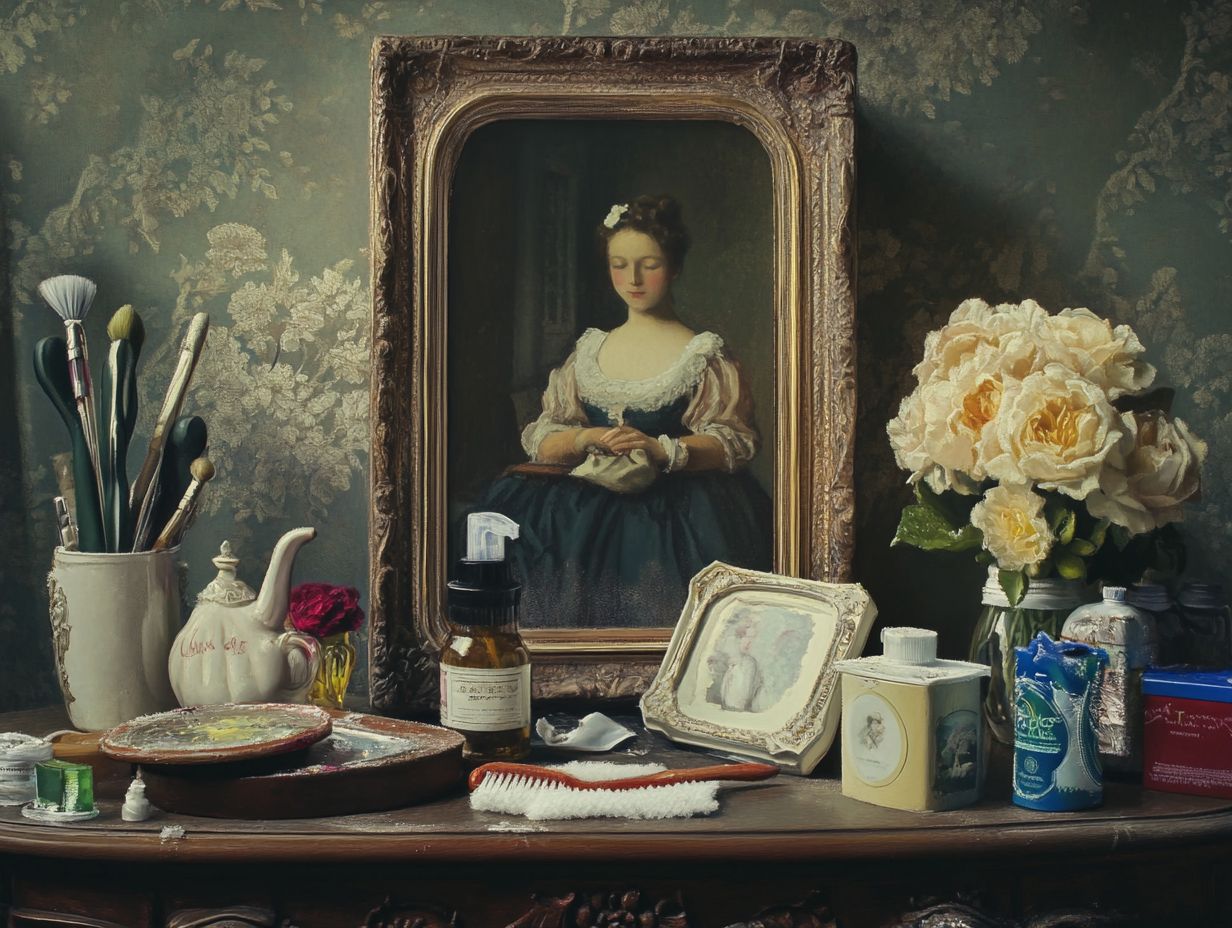
Identifying and addressing common issues like discoloration, cracking, or damage from silverfish pests is crucial for preserving your vintage paintings. Oil paintings are especially susceptible to these problems. By giving prompt attention to these matters, you can prevent further deterioration and successfully restore your artwork to its former glory.
One prevalent issue is discoloration, often resulting from exposure to sunlight or pollutants. This can significantly alter the piece’s original hues. To combat this, consider using UV-protective glass or relocating your artwork away from direct light.
Cracking is another frequent concern, typically caused by fluctuations in temperature and humidity levels. Maintaining a stable environment is key to minimizing this risk.
Your vintage paintings can also fall victim to pests like silverfish, which can inflict severe damage on both the canvas and the paint. Regular inspections and the use of pesticides specifically formulated for art can help you prevent infestations.
Timely intervention in addressing these issues not only enhances the lifespan of your artwork but also preserves its aesthetic value.
Displaying and Storing Vintage Wall Art
Displaying and storing vintage wall art with care is crucial for ensuring its longevity and preservation. By maintaining these artworks properly, you safeguard their visual appeal and historical significance.
Adopting best practices for both display and storage enhances the maintenance of your collection and protects it from environmental damage, allowing you to enjoy these treasures for years to come.
Best Practices for Displaying and Storing
Best practices for displaying and storing vintage wall art include controlling humidity levels, ensuring proper lighting, and using protective glass when framing your artworks. These measures enhance your visual experience and keep the artwork safe.
Consider where you place each artwork in your home or gallery. Choose walls that provide insulation from temperature fluctuations and shield against harmful UV rays. Hanging art away from direct sunlight can prevent fading, while opting for acid-free materials that do not contain acids that can damage the artwork helps avoid deterioration. For more insights, check out our guide on how to frame vintage wall art.
Pairing these strategies with high-quality frames like those crafted from natural wood or metal with non-reflective glass, which minimizes glare creates an inviting display without compromising the artwork’s safety.
By embracing these thoughtful practices, your vintage artwork can transform into a stunning visual choice and a valuable investment for the future.
Tips for Long-Term Care and Maintenance
Long-term care and maintenance of vintage paintings require consistent attention to environmental factors and handling practices, ensuring their preservation for future generations. Implement simple yet effective tips to enhance the longevity of these treasured artworks and maintain their pristine condition.
Maintain a stable environment. Fluctuations in temperature and humidity can seriously harm these delicate pieces. If you’re considering a vintage aesthetic, it’s also helpful to know how to choose vintage wall art for your home. Ideally, vintage paintings should be stored or displayed in a climate-controlled room, with a consistent temperature between 65 and 75 degrees Fahrenheit and relative humidity around 40-50%.
When handling these artworks, always use clean, dry hands or wear cotton gloves to prevent oils and dirt from transferring onto the surface. Regularly assess your pieces for signs of wear, such as discoloration or flaking paint, so you can intervene and care for them in a timely manner.
By following these practices, you can ensure that your valuable pieces remain vibrant and captivating for years to come.
Frequently Asked Questions

What is the best way to care for vintage wall art?
The best way to care for vintage wall art is to avoid direct sunlight, moisture, and extreme temperature changes. Dust regularly and handle with clean hands to prevent damage.
Can I clean my vintage wall art?
Yes, you can clean your vintage wall art, but you must use gentle methods. Avoid harsh chemicals or abrasive materials that can damage the delicate surface of the artwork.
How should I store my vintage wall art?
When storing vintage wall art, it is crucial to protect it from potential damage. Wrap the artwork in acid-free paper and store it in a cool, dry place away from direct sunlight.
What should I do if my vintage wall art gets damaged?
If your vintage wall art gets damaged, seek professional restoration services immediately. Attempting to fix the damage yourself can lead to further harm to the artwork.
Can I hang my vintage wall art in a bathroom or kitchen?
It is not recommended to hang vintage wall art in areas with high humidity, such as bathrooms or kitchens. The moisture in these areas can damage the artwork over time.
How can I ensure the authenticity of my vintage wall art?
To ensure the authenticity of your vintage wall art, conduct thorough research on the artist and the piece itself. Look for signatures or markings that can verify its authenticity. If in doubt, consult with a reputable art appraiser.
If you need assistance with restoration or care, do not hesitate to reach out to professionals! Your vintage art deserves the best care possible.

